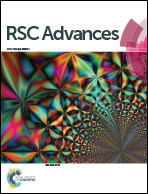DFT study on 1,7-octadiene polymerization catalyzed by a non-bridged half-titanocene system†
Abstract
Polymerization of 1,7-octadiene catalyzed by the (η5-C5Me5)TiCl2(O-2,6-iPr2C6H3)/MAO system exhibited unusual favorable selectivity of repeated insertion. However, the mechanism of selectivity of the insertion mode of non-conjugated dienes has not been reported previously as far as we know. By using the density functional theory (DFT) method, the insertion modes of 1,7-octadiene, especially the selectivity of repeated insertion and intramolecular cyclization, were explored in detail concerning the (η5-C5Me5)TiCl2(O-2,6-iPr2C6H3)/MAO system. At the initiation stage, the 1,2-si-insertion is the optimal pathway among four insertion modes kinetically and thermodynamically. At the chain propagation stage, the competition between repeated insertion and intramolecular cyclization was discussed in detail, concerning the insertion into different growing chains. The computational results indicated that the repeated insertion of 1,7-octadiene showed more kinetically favorable than the intramolecular cyclization in three different situations, with free energy barrier differences between two insertion modes of 3.75 kcal mol−1, 3.88 kcal mol−1 and 7.43 kcal mol−1 respectively. Moreover, the sequential insertion of seven-membered rings exhibited disadvantageous kinetically and thermodynamically, probably due to the steric repulsion effect between two cyclic rings. Those are in good agreement with the experimental data.


 Please wait while we load your content...
Please wait while we load your content...